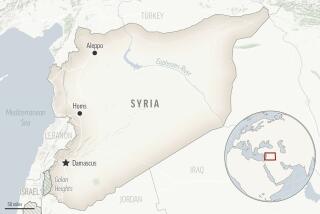At least three allegations of chemical use in Syria
BEIRUT — Last week’s allegations from top U.S. officials that Syrian forces probably deployed chemical weapons against rebels come amid an array of disputed reports about purported chemical attacks in Syria.
There have been at least three incidents — all unconfirmed — in which reports surfaced publicly that chemical weapons had been deployed in Syria, either by the government or rebels. All have been relatively small scale considering the fact that agents such as sarin can cause mass casualties. It’s not clear which, if any, of the incidents are involved in the U.S. allegations against Syria.
The most high-profile of the incidents allegedly occurred on March 19 in the town of Khan al Asal, outside the northern city of Aleppo. The government said 25 people were killed and more than 110 were wounded in a poison-gas assault.
The government and the opposition exchanged blame for the attack, a pattern of cross-accusations that has recurred repeatedly following mass killings in Syria. But accounts from both sides agreed that the casualties occurred after a rocket strike and included both civilians and an unspecified number of regime troops.
The Syrian government said “terrorists” based in a nearby area launched a rocket at 7:30 a.m. containing “chemical materials.” The rocket struck about 300 yards from a Syrian army post, the state press agency said.
The opposition countered that the Syrian military fired a chemical-tipped Scud missile.
According to the official account, the casualties resulted from both the explosion and the gases unleashed upon impact. It was never clear how many of the victims succumbed to the alleged gas.
Official video and photographs said to be from a hospital in Aleppo showed purported victims breathing through oxygen masks. The substance caused “immediate fainting, convulsion and death,” the Syrian information minister, Omran Zoubi, told reporters.
The government suggested that rebels may have armed a missile with a chlorine derivative looted from an Aleppo factory. Chlorine, widely used as a water purifier and in other industrial applications, was deployed on a large scale as a chemical weapon almost a century ago in the trenches of World War I. Some accounts of the March 19 attack indicated that the odor of chlorine was noticeable at the site.
Experts interviewed after the attack generally said that the casualty numbers would have been much higher if the missile had been armed with a nerve agent like sarin, which is believed to be in the Syrian government’s arsenal.
After the attack, Syrian officials alleged that the opposition used a laboratory in adjoining Turkey to fabricate the toxic material. The aim, according to Syrian officials, was to create a false-flag scenario in which the Syrian military was accused of deploying chemical weapons — thus triggering international intervention.
The Syrian government reportedly took soil samples from the site and blood samples from victims to be used in any United Nations investigation.
As the March incident caused an international uproar, the opposition charged that the government had also fired chemical weapons on the same day in the disputed township of Otaybah, east of Damascus, the capital. Details about that alleged attack have remained sketchy, though rebels say the strike caused both deaths and injuries. The opposition has since alleged several other incidents involving chemical gas attacks.
The first flurry of allegations about chemical weapons use in Syria involved an incident late last year in the heavily contested central city of Homs. On its website, Foreign Policy magazine in January cited a secret State Department cable that concluded, after an extensive consular investigation, that Syrian authorities probably deployed chemical weapons on Dec. 23 in Homs.
However, the U.S. State Department later categorically distanced itself from the report, which it said was based on “anecdotal” information. State Department spokeswoman Victoria Nuland told reporters in Washington on Jan. 16 that investigators “found no credible evidence to corroborate or to confirm that chemical weapons were used” last December in Homs.
When the U.S. charged last week that it appeared Syria had used sarin gas in unspecified attacks, the Syrian government denounced the allegations as a “bare-faced lie.” A top Russian diplomat warned in a visit to Lebanon this weekend that the charges should not be used as an “pretext” for an Iraq-style intervention in Syria, Moscow’s long-time ally.
Still, the explosive accusations raised the specter that Damascus may have crossed the Obama administration’s “red line” for possible stepped-up intervention in the conflict, which has been going on for more than two years. U.S. officials conceded that the proof of two reported instances of the nerve agent was not conclusive, and the “chain of custody” of the substances was unclear.
Experts say it is almost impossible to make an accurate determination without access to the impacted site and laboratory examinations of samples of soil, blood, urine or human tissue. The evidence that has emerged publicly so far appears to involve photographs of purported victims and alleged traces of toxins found in individuals and possibly in soil.
A planned United Nations inquiry remains stalled amid differences between the U.N. and the Syrian government about how much access the investigators will have in the country.
ALSO:
Syrian official denies allegations of chemical weapons use
Muslim clerics in Syria urge release of kidnapped bishops
Palestinians start work to form new government
More to Read
Start your day right
Sign up for Essential California for news, features and recommendations from the L.A. Times and beyond in your inbox six days a week.
You may occasionally receive promotional content from the Los Angeles Times.






